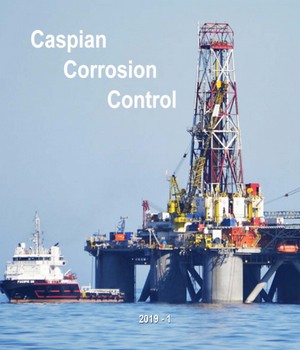Caspian Corrosion Control 2019
__________________________________________
S.Ch.Verdiyev, M.G.Tagirli, T.A.Agalarova, S.M.Valiyeva, A.S.Huseynova
Institute of Catalysis and Inorganic Chemistry Named After acad. M.F.Nagiyev ANAS, Baku, Azerbaijan
The synergistic effect of oxidizing agents mixed with amines in single and two-phase electrolyte – hydrocarbon media has been studied and it has been shown that the simultaneous introduction of potassium chromate, sodium molybdate, sodium nitrite and sodium iodate and monoethanolamine into a corrosive environment increases the degree of protection (15–20%). It has been established that monoethanolamine mixed with oxidizing agents in 3% NaCl solution plays the role of a synergist.
Keywords: Inhibitor; Synergism; Two-Phase Medium
__________________________________________
F.Q.Valiyev, Z.A.Shabanova, E.F.Sultanov, S.B.Alyeva, U.E.Hasanova
«OilGasScientificResearchProject» Institute, SOCAR, Baku, Azerbaijan
On the basis of amines and thio compounds new type inhibitor compositions for zinc bromide and calcium bromide based brinest have been developed By the method of gravimetric testing in the laboratory in the temperature range of 120-150 оC investigated the inhibiting properties of the developed inhibitor compositions. Tests have shown that the synthesized corrosion inhibitors can effectively control the corrosion of carbon steel in high density brines at high temperatures. It was found that the effectiveness of inhibition of the developed inhibitor compositions after 72 hours of testing is 93-98%, respectively.
Keywords: Corrosion; Inhibitor; Heavy Brines
__________________________________________
F.S.Ismailov , X.I.Hasanov , G.I.Ajalova
«OilGasScientificResearchProject» Institute, SOCAR, Baku, Azerbaijan;
Azerbaijan Medical University, Baku, Azerbaijan
The interaction of platinum (II) and palladium (II) salts under certain conditions with such ligands as cysteamine- (mercamine) HSCH2CH2NH2 and 2-mercaptoethanol - HSCH2CH2OH results in the formation of polynuclear complexes: [Pt6(SCH2CH2NH2)8]Cl4, [Pd6)8]Cl4·5H2O, [Pd6(SCH2CH2OH)12]Cl4·3H2O and [Pt6(NH2CH2CH2S)8]Cl4·3H2O. Based on a comparison of the IR and X-ray spectra of the synthesized complexes and ligands, as well as the X-ray results, it was found that in palladium (II) complex sulfur atoms of 2-mercaptoethanol occupy a bridging position with a displaced coordination of ligands. In the platinum (II) complexes, the bidentate coordination of ligands with sulfur and nitrogen atoms is realized. The synthesized complexes in spite of having the same compositions but differ greatly in structure.
Keywords: 2-mercaptoethanol; Cysteamine; Mercamine; Cluster; Chelation; Platinum and palladium complexes; Mixed coordination; Bridge position; Structure.
__________________________________________
N.P.Mustafayev, N.N.Novotorjina, Q.Q.Ismailova, B.I.Musayeva, M.R.Safarova, Q.A.Qahramanova, I.P.Ismailov
Institute of Chemistry of Additives named after аcad.A.M.Guliyev, Baku, Azerbaijan
By xanthogenate methylation of dioxolanes was obtained 2.2-dialkyl-4- butoxy (ethoxy) thiocarbonylthi-omethyl-1.3-dioxolane in the presence of p-toluenesulfonic acid catalyst (TsOH · H2O). A study of the synthesized compounds as additives to industrial oils has been carried out, their high antiseize efficiency and the possibility of being used as acceptable components in the manufacture of industrial oil INSP-40, used for lubricating light and mediumloaded horizontal guides and gear oil ITD-32 for lubricating gears and other elements of industrial equipment.
Keywords: Xanthogenomethylation; Glycerin; Acetal; Additives.
__________________________________________
F.A.Novrusova, Kh.Sh.Hajiahmadzadeh, E.T.Bagirova
M.F.Nagiyev Institute of Catalysis and Inorganic Chemistry, NAS of Azerbaiyjan Baku, Azerbaijan
The temperature dependence of specific heat of poly(isobutene) degraded under the action of strong Lewis acids has been investigated. From the calculated thermodynamic parameters have been drawn conclusions on the structural conversions of the macromolecules in the process of catalytic degradation. By means of 13C NMR the formation of branched macro- molecules was shown. On the basis of the results a degradation mechanism for poly (isobutene) is suggested.
Keywords: 13C nuclear magnetic resonance spectra; Catalyst; Polyisobutylene; Lewis acids; Polyolefin; Cationic; Ion-coordination; Free radical; Carbocation.
__________________________________________
A.K.Kazim-zadeh, E.A.Nagiyeva, A.A.Gadirov, R.A.Mammadova, B.I.Abdullayev, M.A.Mirzoyeva
Institute of Chemistry of Additives named after аcad. A.M.Guliyev, Baku, Azerbaijan
New multifunctional nitrogen containing alkylphenolate AKI-136 additive, preseviting itself as carbonated calcium salt of alkylphenol, formaldehyde and 4-aminopiridine was synthesis and research. AKI-136 additive was researched both in an individual form, and in the composition of M-10G2 engine oil. The research showed that AKMechanism of Oxidative Dehydrogenation of Naphthenic Hydrocarbons Over Modified Zeolites Z.A.Shabanova «OilGasScientificResearchProject» Institute, SOCAR, Baku, Azerbaijan A b s t r a c t It has been suggested the general kinetic scheme of mechanism and theoretically based kinetic model of oxidative dehydrogenation of naphthenic hydrocarbons over modified zeolites, which described formation of the main and by-products. Numerical values of kinetic parameteres have been calculated.I-136 additive possesses high thermooxidative, anticorrosion and detergent properties. It has been established that motor oil M-10G2 with AKI-136 additive possesses high functional properties and meets the requirements of GOST for this oil. The high functional properties of AKI-136 additive allow it to use for preparing modern motor oils.
Keywords: Alkylphenol; Formaldehyde; 4-Aminopiridine; Additive; Motor oil.
__________________________________________
Z.A.Shabanova
«OilGasScientificResearchProject» Institute, SOCAR, Baku, Azerbaijan
It has been suggested the general kinetic scheme of mechanism and theoretically based kinetic model of oxidative dehydrogenation of naphthenic hydrocarbons over modified zeolites, which described formation of the main and by-products. Numerical values of kinetic parameteres have been calculated.
Keywords: Mechanism; Model; Oxidative dehydrogenation; Zeolite; Naphthenes
__________________________________________




